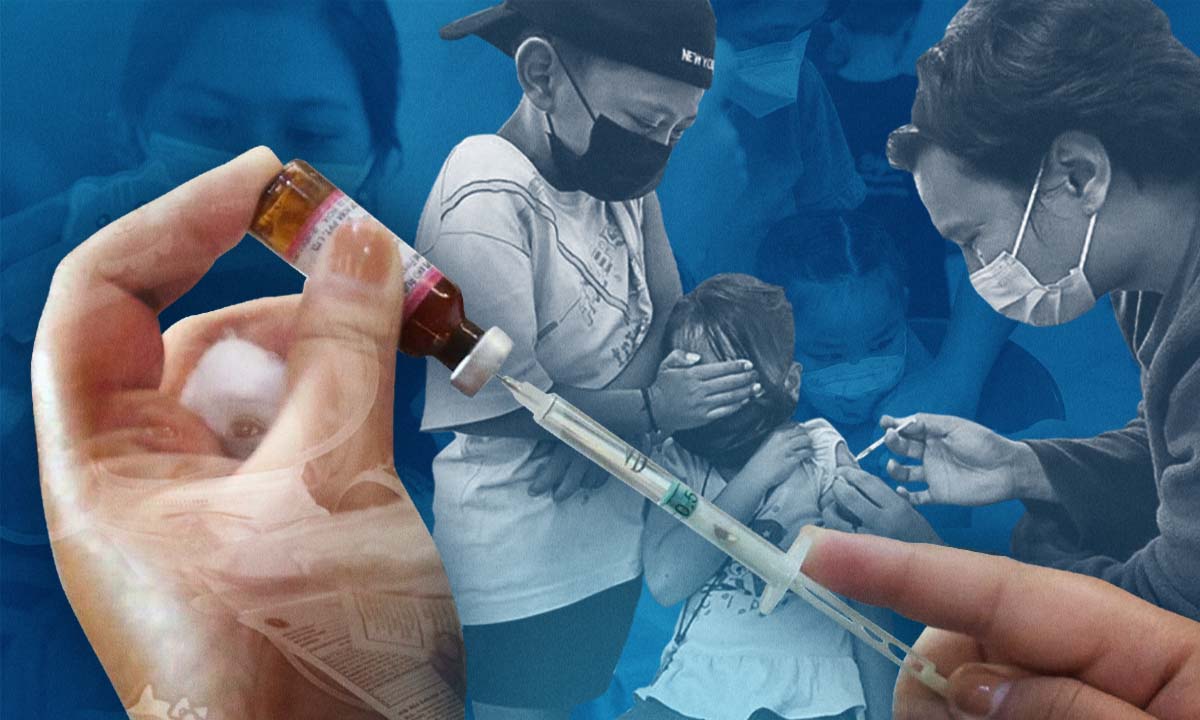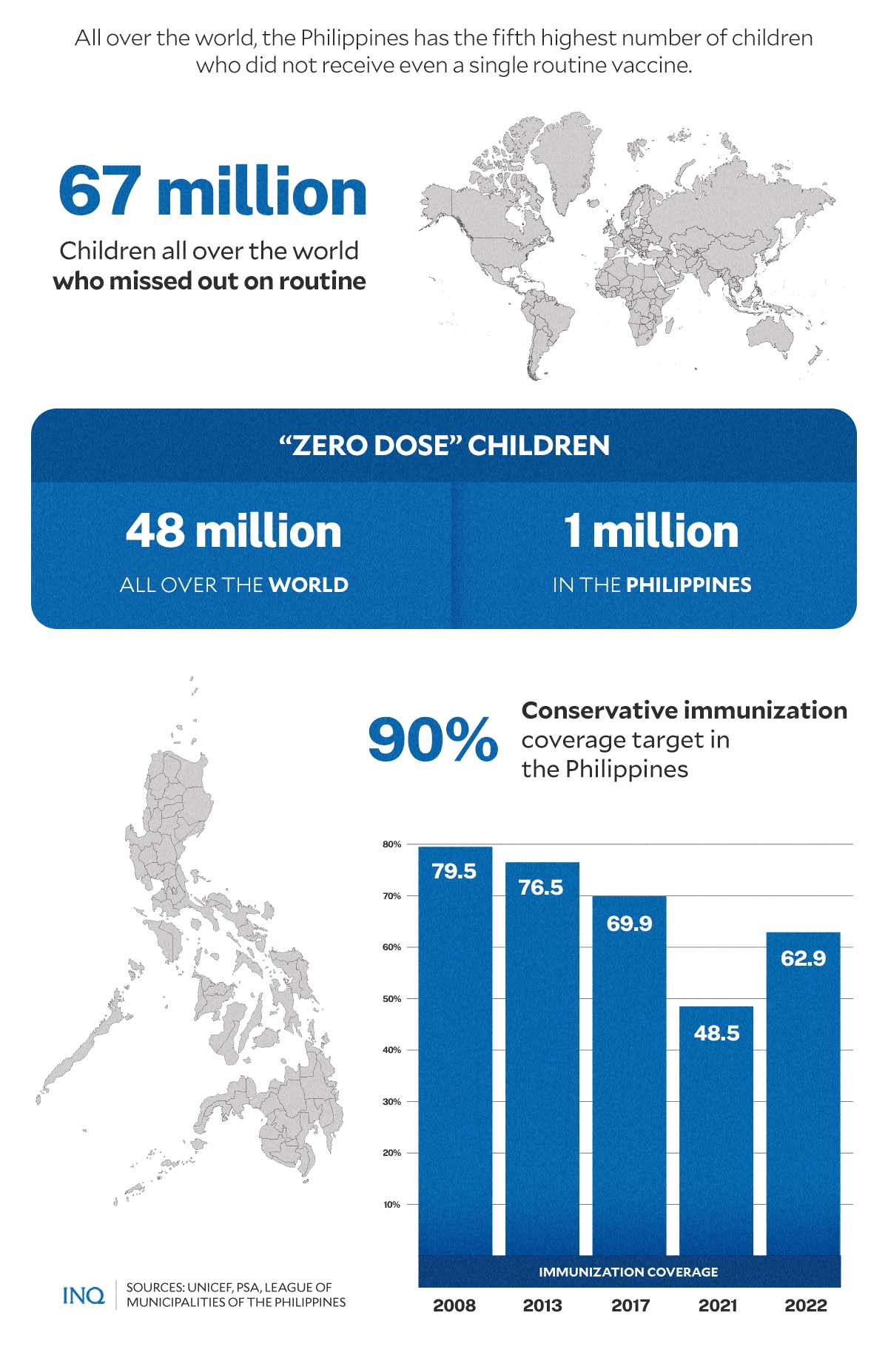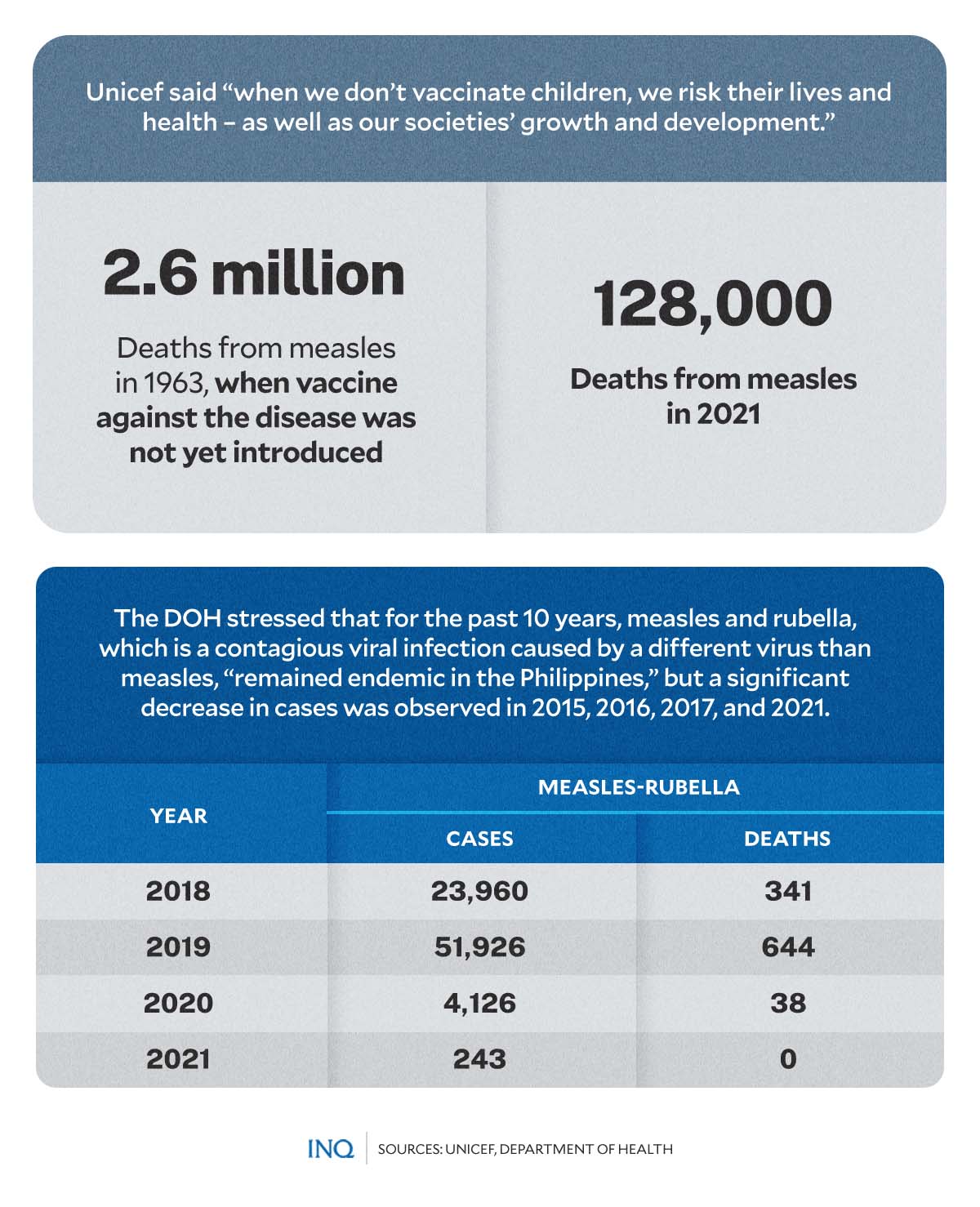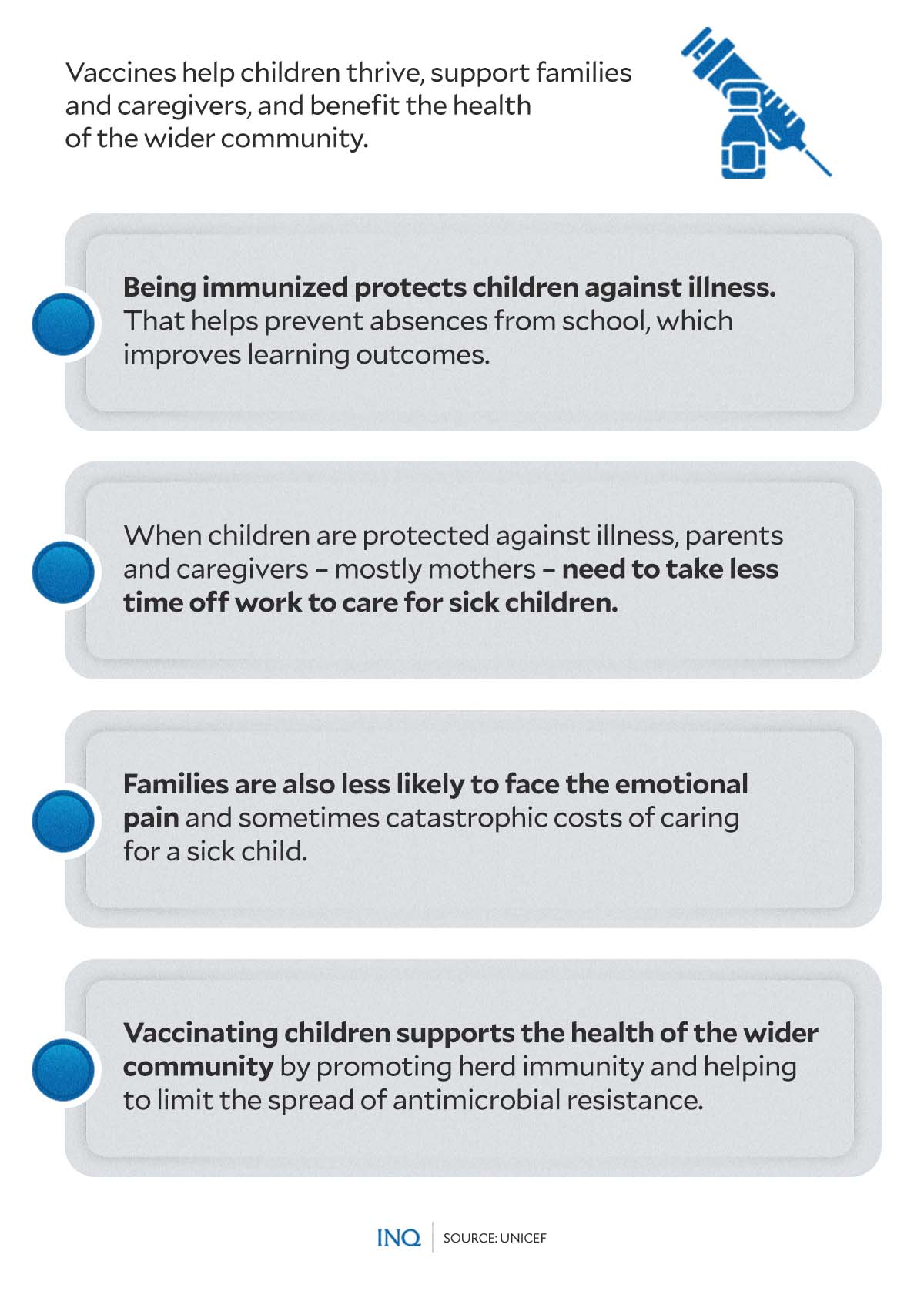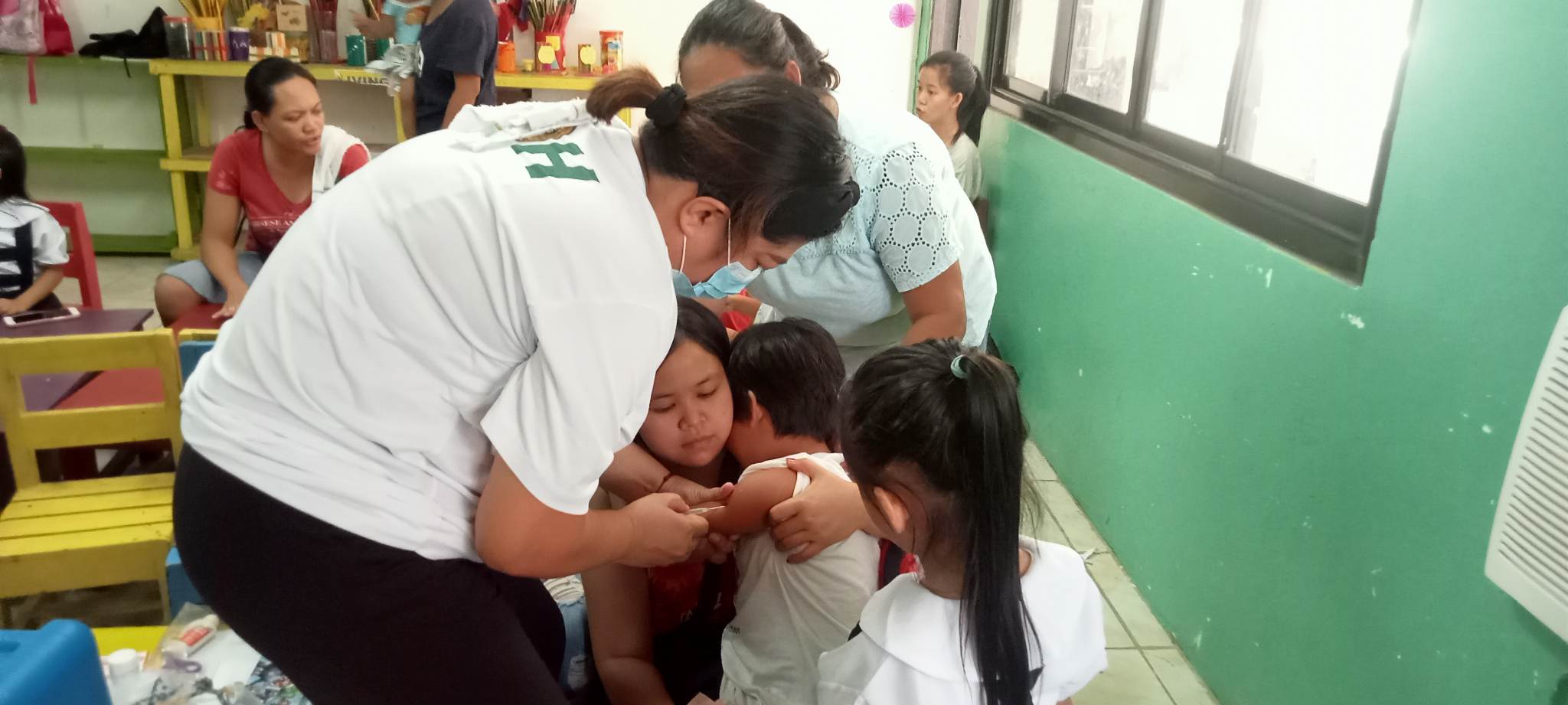As 1M PH kids get zero vaxx, LGUs urged to take campaign back on track
MANILA, Philippines—All over the world, the Philippines has the fifth highest number of children who have not received even a single routine vaccine, so the League of Municipalities of the Philippines (LMP) called on local governments to “prioritize routine and catch-up immunization.”
Based on data, which was released by the United Nations Children’s Fund (Unicef), there were 67 million children all over the world who missed out on routine vaccination between 2019 and 2022.
Of this, 48 million were “zero dose,” or children who did not receive a single routine vaccine. The Philippines, Unicef said, has one million zero-dose children, the second highest in East Asia and the Pacific and the fifth highest in the world.
This is alarming, especially since Unicef stressed in its report—“The State of the World’s Children 2023”—that “when we don’t vaccinate children, we risk their lives and health, as well as our societies’ growth and development.”
But now that the LMP called on its member municipalities to double down on routine and catch-up immunization, the Philippines’ battle against preventable diseases can get back on track.
This, as Barcelona, Sorsogon Mayor Cynthia Falcotelo-Fortes, secretary general of the LMP, stressed that “the success of vaccination relies heavily on the implementation of local government units (LGUs).”
She said: “Yes, we get regular support from [the] Department of Health (DOH)—from the supply of the vaccines under the National Immunization Program (NIP) to even disease awareness support under its Healthy Pilipinas campaign.”
READ: DOH launches nationwide immunization drive vs measles, rubella, polio
“But these should not be the only programs out there,” she said.
“An LGU is empowered to proactively initiate local programs and be as creative as they can to increase its local immunization rates using its available resources,” Falcotelo-Fortes said.
Immunization saves lives
According to the US Centers for Disease Control and Prevention’s (CDC) list, 14 diseases are deadly but preventable through routine vaccinations—measles, polio, tetanus, rubella, diphtheria, and pertussis, among others.
Unicef said before the introduction of vaccines in 1963 measles, which is a highly contagious and serious disease, killed an estimated 2.6 million people all over the world, most of them children.
But by 2021, the number of deaths from the disease fell to 128,000. While this was “still too high,” Unicef said there was a “remarkable improvement” compared to decades ago.
As Unicef stressed, immunization saves 4.4 million lives every year. This, however, could still rise to 5.8 million by 2030 if the goals of the Immunization Agenda 2030 are met.
According to Department of Health (DOH) data, for the past 10 years, measles and rubella, a contagious viral infection caused by a virus different from measles, “remained endemic in the Philippines.”
The DOH said in 2014, 2018 and 2019, “outbreaks were declared wherein measles and rubella cases were observed to be the highest.” A significant decrease, however, was observed in 2015, 2016, 2017 and 2021.
As the DOH stressed, the rise in cases may be because of its “preventive and control response” through supplemental immunization activities and the effect of COVID-19 restrictions in 2020 and 2021.
DOH data showed that there were 23,960 cases of measles and rubella in 2018; 51,926 in 2019, when an outbreak was declared in Luzon, the Visayas and some parts of Mindanao; 4,126 in 2020; and 243 in 2021.
There were 341 deaths from measles and rubella in 2018 then 644 in 2019, but mortality fell to 38 in 2020. There were no deaths in 2021, indicating a 100 percent decrease compared to the previous year.
Setback
Unicef said “vaccines are among the greatest advances in global health and development,” stressing that for over two centuries, vaccines have safely reduced the scourge of diseases like measles and polio, a crippling disease.
However, “for the first time in three decades, we are witnessing the largest sustained backslide in childhood vaccinations,” especially because of COVID-19 disruptions, conflict, displacement and increasing vaccine misinformation.
READ: COVID worsens ‘largest backslide’ in child vaccinations in 30 years
As a result, millions of children are now missing out on life-saving vaccines every year, “placing them at risk from devastating and entirely preventable diseases like measles and polio.”
According to an LMP statement, Dr. Anna Ong-Lim, a pediatric infectious disease expert, said most of the Philippines’ immunization coverage is roughly about 50 percent, which is way below the 90 percent “conservative target.”
She said because of the COVID-19 crisis that started to hit in 2020, routine immunization went down to an all-time low of 48.5 percent in 2021. This recovered, though, to 62.9 percent in 2022.
Compared to previous immunization levels, the 48.5 percent and 62.9 percent are way lower than 69.9 percent in 2017 and even higher 76.5 percent in 2013 and 79.5 in 2008, according to Philippine Statistics Authority (PSA) data.
Ong-Lim stressed the urgent need to “double-time on increasing childhood vaccination in the country,” pointing out that “if vaccination rates continue to be low, children are at constant risk of contracting infectious diseases.”
“If there are still a lot of children who are not protected [against infectious diseases], they can be the source of transmission,” she said. “There is an opportunity to bounce back and ramp up routine and catch-up immunization.”
LGUs role
The LMP committed to support the national government’s efforts in implementing timely routine and catch-up vaccination of children all over the Philippines through the NIP.
It said local governments have a crucial role in realizing this goal, so mayors should “proactively coordinate with the national government and initiate activities that [will] ramp up the community’s vaccination rate.”
But why?
According to Minnie Parallag, head nurse at the Rural Health Unit (RHU) of Alicia, Isabela, without the LGU’s assistance, immunization of hundreds of children in the municipality would not be possible.
RELATED STORY: Nancy Binay calls for ramped-up vax efforts for zero-dose children
She told INQUIRER.net through a phone call on Tuesday (May 9) that with the help of the local government, “health workers are being able to reach even the farthest barangays to vaccinate children against contagious but preventable diseases.”
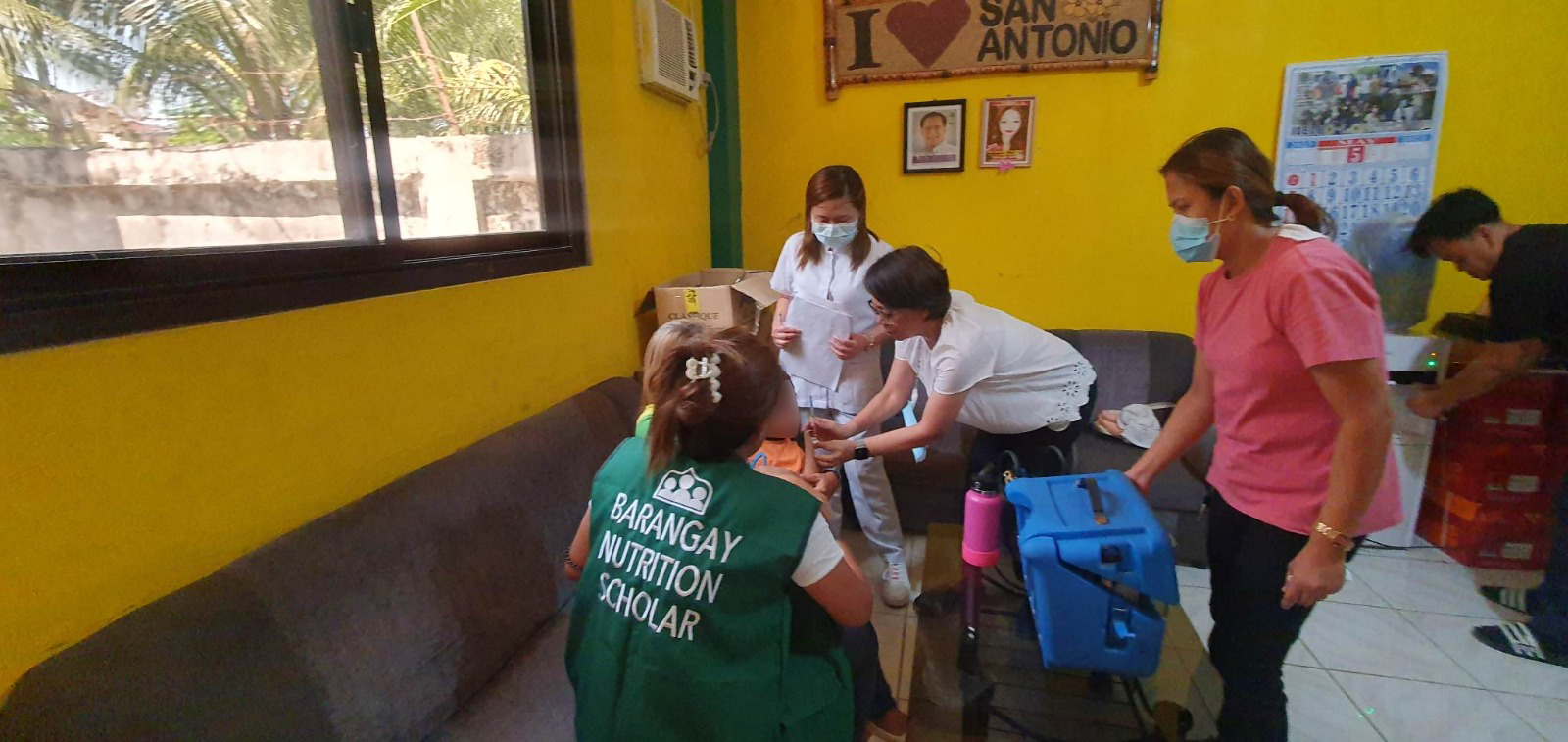
HEALTH SHIELD. Children in Alicia, Isabela get vaccinated through the immunization program of its Rural Health Unit in several barangays. PHOTOS COURTESY OF MINNIE PARALLAG
Paralleg pointed out that the LGU also assists them in coordinating with officials and health workers in the barangays to provide the necessary medical help that a mother and infant need from pregnancy to birth.
This, as she stressed that LGUs should always understand that vaccines are the safest way to protect people, especially children, against certain diseases and prevent serious illnesses.
Falcotelo-Fortes called on all local executives to “coordinate with the DOH and maximize your resources to improve your local community’s immunization rate,” pointing out that “the national government cannot do it alone.”
“It takes all of us to achieve the national target and protect our children from vaccine-preventable diseases,” she said. “If the program reaches us, we are accountable, and that success rate, we will define.”
Hesitancy increasing
Unicef said “we know that immunization is one of the most effective public health interventions, giving every child the opportunity to grow up healthy and reach their full potential.”
It stressed that this was why it is “working tirelessly to make sure that every child, regardless of where they are, has access to the vaccines they need to not only survive, but thrive.”
RELATED STORY: As vaccination rates plummet, children face bigger monster—wasting
But despite decades of progress in childhood vaccination, “our collective efforts are falling short” and then the COVID-19 crisis “has only darkened this picture,” stressing that in the past three years, more than a decade of hard-earned gains have been eroded.
“Getting back on track will be challenging,” it said, especially since public perception of the importance of vaccines for children declined in 52 out of 55 countries studied by Unicef.
Based on Unicef’s Vaccine Confidence Project, the perception of vaccine importance for children declined by about 25 percent in the Philippines and by more than a third in the Republic of Korea, Papua New Guinea, Ghana, Senegal, and Japan.
READ: PH confidence on vaccine for kids declines by 25% — Unicef
China, India, and Mexico were the only countries studied where the data indicated that the perception on importance of vaccines held firm or even improved after the start of the COVID-19 crisis.
“This is why the dissemination of the right information, like what we are already doing, is more important than ever,” Parallel said.
As stated in the Unicef report, the confluence of several factors suggests the threat of vaccine hesitancy may be growing. These factors include uncertainty about the response to the pandemic, growing access to misleading information, declining trust in expertise, and political polarization.
Unicef said “in the Philippines, vaccine hesitancy can be attributed to cultural factors, and concerns on vaccine safety.”
“Children born just before or during the pandemic are now moving past the age when they would normally be vaccinated, underscoring the need for urgent action to catch up on those who were missed and prevent deadly disease outbreaks,” said Unicef.
